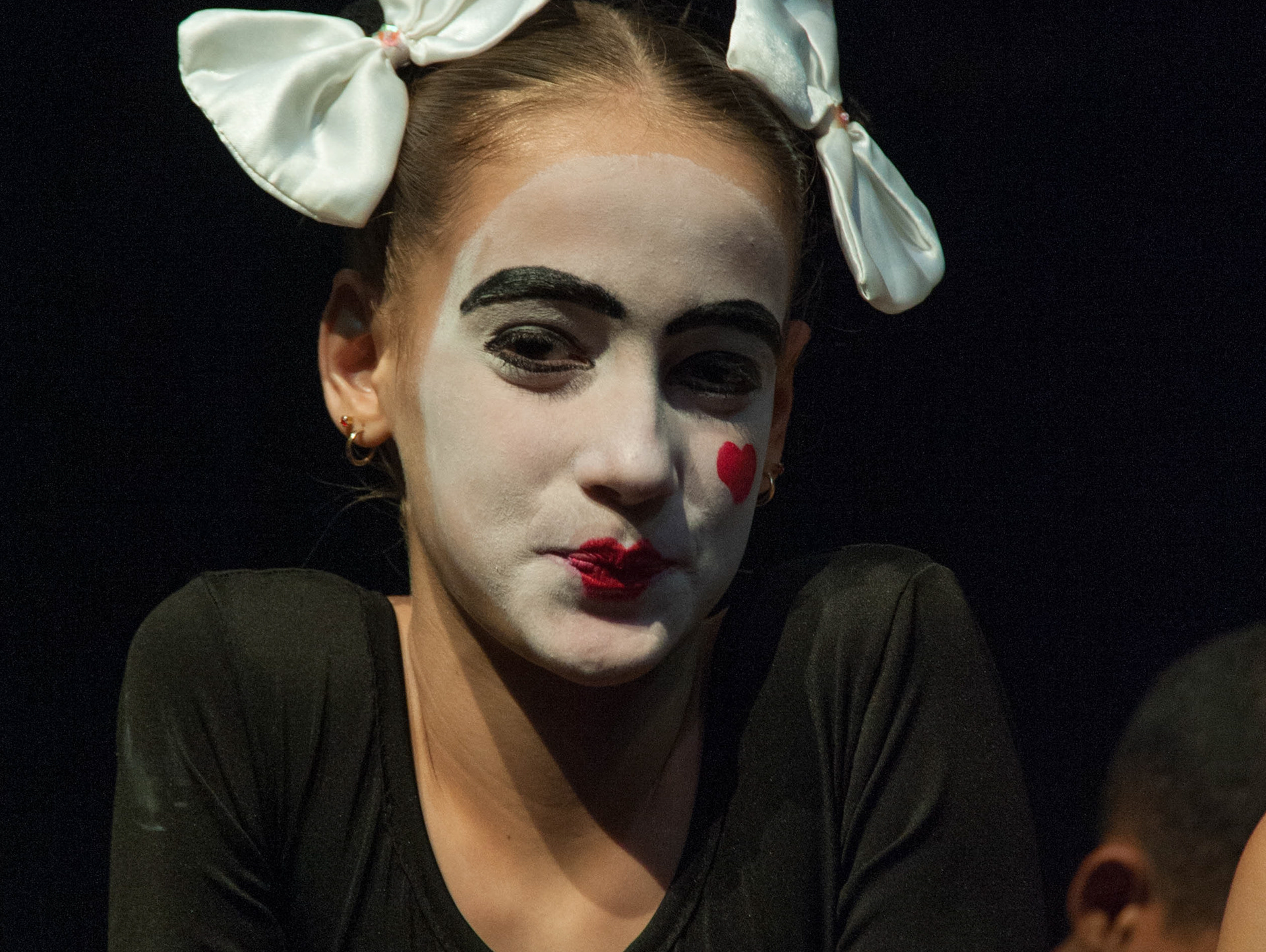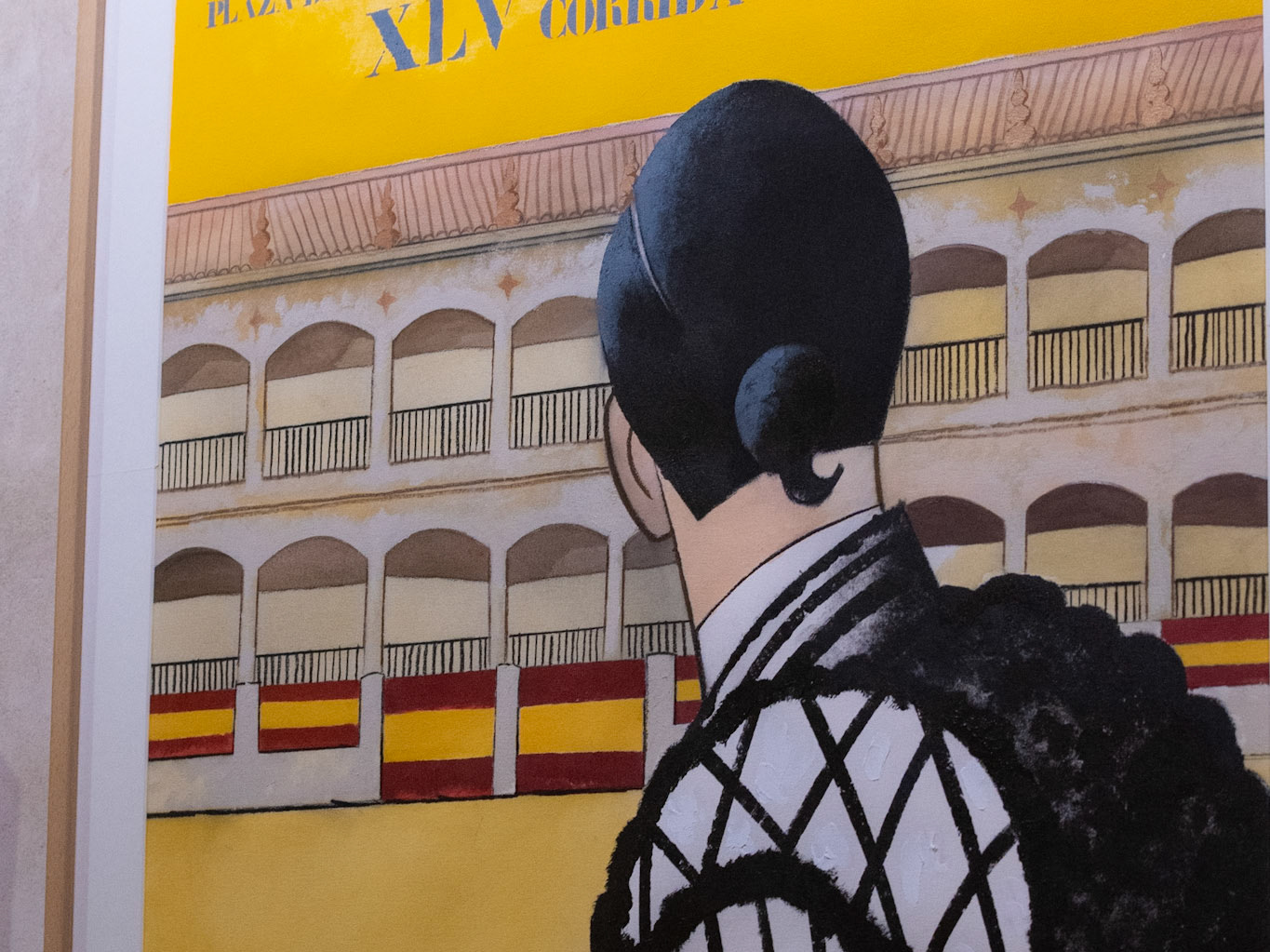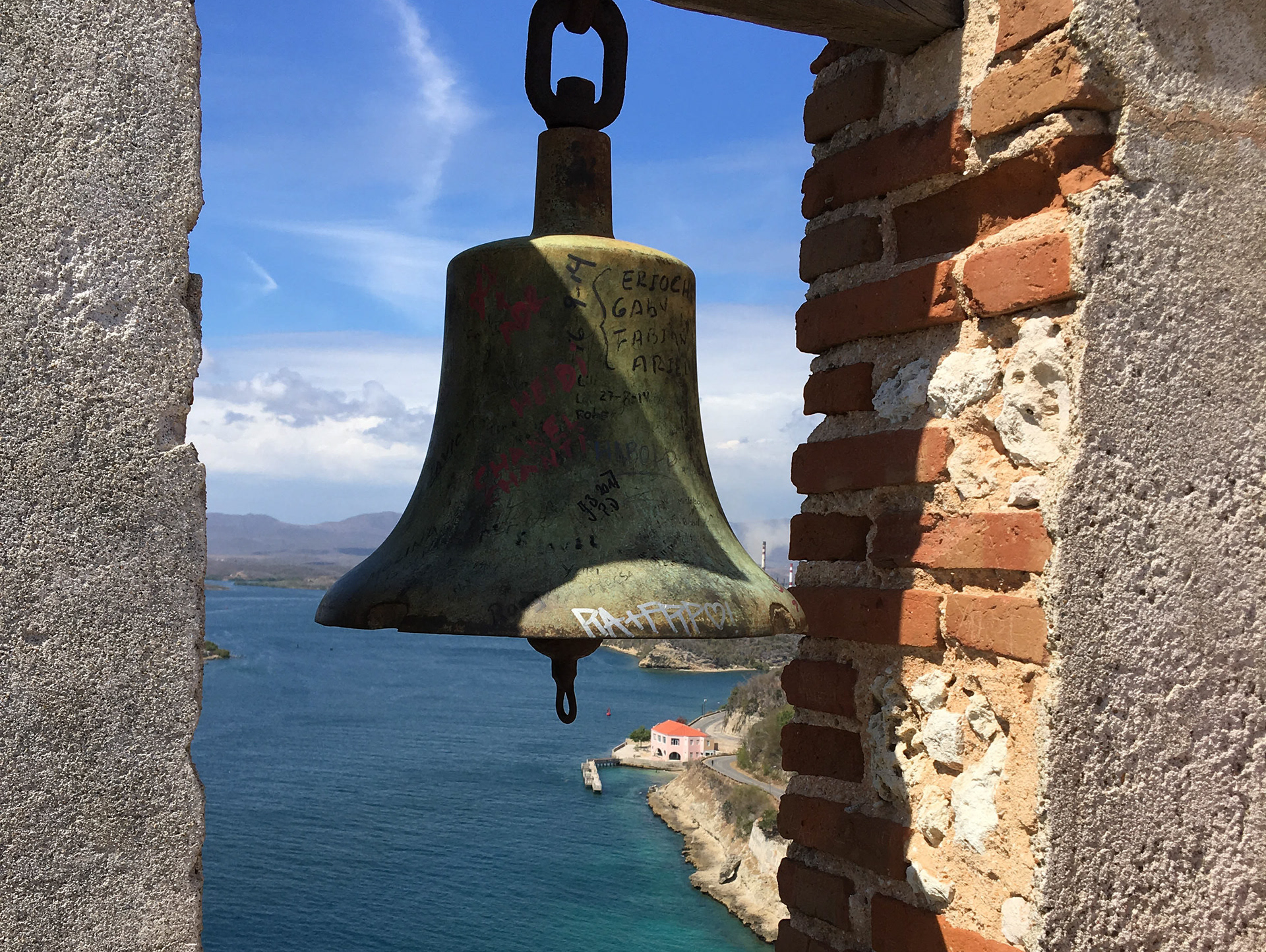A street performer....who doesn't actually blow a note. National Geographic tour book: "In Habana Vieja the mulattas in colorful costume expect to be paid." Hard currency, necessary to buy all but the most basic necessities, is most readily avaiable from tourist tips. Asking permission for photos here is more than nice etiquette.
Antique cars in daily use. A big topic; addressed in an upcoming project.
Che Guevara: A hero of the 1960s revolution, this image is common throughout Cuba. This huge rendering is on the Minister of the Interior building.
A militant physician who tried to export armed rebellion to Central America and even Africa, Che's lionization is somewhat less understandable to an American physician pacifist. To the Cubans, however, he is one of the major revolutionary heroes besides, of course, Fidel Castro himself.
Camilo Cienfuegos: Another revolutionary hero, this time on the Ministry for Information and Communications. He was best known for his leadership of Cuban troops who were sent to Angola by Fidel Castro, and died in a plane crash whose circumstances led to some controversy. That controversy was dismissed by many as American propaganda.
Monument to Jose Marti, born in 1853 Havana to Spanish immigrant parents, who devoted his life to revolutionary independence from Spain in the First War of Independence. A poet and writer with extensive academic and literary credentials, he is widely revered as the "spiritual father of the revolution." His likeness in busts appears throughout the country. He died during the first battle with the Spanish army in which he participated.
Antique and new taxis; the orange car in the center is of Chinese manufacture.
The bed of this antique Ford truck has been adapted for hauling people. These "camiones" are the most common form and the least expensive motorized form of intra and interurban travel
Called "cocotaxis", common in Havana. All drivers of motorcycles, scooters, and these wear helmets. Not so the tourists.
1955 Chevrolet: The nicest antique cars have been fixed up to serve the tourist trade; a tour of Havana costs $30-40.
Catedral San Cristobal in Plaza de la Catedral, Havana
Nearby, a tourist and a rather stiff Cuban hold up an ancient column
Plaza de la Catedrale
Looking southeast from Plaza de la Catedrale
Iglesia y Convento de San Francisco de Asis, on San Francisco square. It has not been used for Catholic services since 1762 and now serves as a concert hall and museum. We arrived just before closing time.
Statue of Caballero de Paris, National Geographic Traveler guide says:"a stylish Havan tramp of the 1950's....slightly demented but harmless vagabond well known throughout the city...well-liked." His brass beard is passively polished by passersby who touch it for good luck. We only witnessed this on the part of tourists.
Also next to San Francisco church (now and for many years a museum), this statue is presumably St. Francis of Assisi
Galeria Carmen Montilla Tinoco, Plaza de San Francisco. Through its entrance, one enters a beautiful sculpture garden
Galeria Carmen Montilla Tinoco, Plaza de San Francisco.
Galeria Carmen Montilla Tinoco, Plaza de San Francisco.
Tourist shop, Plaza de San Francisco. Brightly dressed Cuban street performer was later seen seeing candy and popcorn out of a grocery cart.
Street performers and photographers. The former were dancing on stilts.
Escuela Taller, an institution focussed on restoration of Cuba's many architectural treasures
Escuela Taller, a class of students selected from several hundred applicants. Trainees focus on all facets of architectural restoration, including plasterwork, bricklaying, carpentry, art conservation, mold making, stained glass, ironwork, and other things. They typically specialize in one of these; their future employment is guaranteed not only by the state to whom they owe 2 years of service for their tuition-free training, but also by the huge backlog of decaying buildings hundreds of years old throughout the country.
I pointed out to the master of the program that his skill would be highly marketable in older areas of the US. He immediately supplied me with his card.
Fidel forever!
Escuela Taller
Escuela Taller. Unexpected wall art of high quality pops up repeatedly throughout the cities through which we travelled.
Escuela Taller
Escuela Taller
Escuela Taller. Wall decoration uncovered during building restoration.
Building undergoing restoration adjacent to Escuela Taller
Tourist shop across from Escuela Taller. These typically are staffed by hired persons. Ownership of these and various enterprises is often private, in contrast to state-owned buses, hotels, and money exchange services. Private owners of tourist related industries, such as restaurants, may make several hundred thousand USD yearly.
This and the next 2 images were taken from the roof of the building which houses the Camara Oscura, Plaza Vieja (though not with the Camara Oscura):
LaHabana.com: "Located on the top floor of the eclectic early 20th-century Gómez Vila Building, 35 meters (115 feet) off the ground, the Cámara Oscura provides a 360-degree panoramic view of much of Old Havana. It is a gift from the Council of Cadiz, Spain, through the City Historian’s Office. It is the only one of its kind in Latin America and the Caribbean, and is one of 74 worldwide today."
It uses a peephole camera projection technique attributed to Leonaro Da Vinci.
Terminal Sierra Maestra, San Francisco Square. Any irony here? The Sierra Maestra were the mountains in which Fidel Castro hid while regrouping for his revolutionary military campaign against Batista, the American Mob, and their United States Government supporters. The Sierra Maestra Terminal is the debarkation point for American tourist boats.
Restoration is underway on the old Capitol Building. Designed as a copy of the US Capitol, it was unused for many years after the Revolution in the 1960s. It will house the Cuban National Assembly in the near future.
Plaza Vieja, Cafe el Escorial
Plaza Vieja, Cafe el Escorial
Plaza Vieja, Cafe el Escorial: The coffee drinks were fantastic and inexpensive
Plaza Vieja
Plaza Vieja
Plaza Vieja: Unnamed statue installed in 2013; one internet contributor hesitated to describe this statue for fear of becoming censored from further internet contribution.
Plaza Vieja, Helado Coco Glace: Coconut based ice cream
Plaza Vieja, adjacent to other vendor
Near Plaza Vieja, these 2 dogs have tags indicating that they have been neutered. The only 2 such tags we saw in Cuba.
Receiving delivery from the 3rd floor, Havana
Sloppy Joe's Bar: Reportedly the original site of....the Sloppy Joe. Always wondered where that came from.
Sloppy Joe's Bar
Sloppy Joe's Bar
Sloppy Joe's Bar
Art market, Havana
Plaza de Armasl
Castillo de la Real Fuerza
Near Plaza de Armas
Private B and B. Note Che on the wall.
LADA; imported from Soviet bloc in that era. Made from Fiat-sourced dies
Dominoes and chess are often seen played in the street
Fiat from the 60s, battered but running
Street marketer to the tourists
Above the entrance to a shop
Patrons in a government store. Currency used is the lesser valued Cuban peso (there are 2 currencies). During consultations with most citizens a few years back, the continued existence of ration cards was affirmed. These cards can be used for a small amount of food; additional food is available at low (subsidized) cost.
Tourist challenged to buy a salad for $1 purchases several tomatoes at the government store
1960s Rambler: tattered body. Note small rear wheels. In everyday use, most antique cars have been extensively modified over the years. Due to the embargo, "necessity is the mother of invention."




